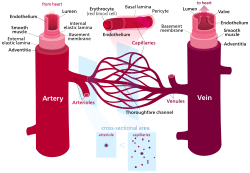| Blood vessel | |
|---|---|
 Diagram blood vessels | |
| Details | |
| System | Circulatory system |
| Identifiers | |
| Latin | vas sanguineum |
| MeSH | D001808 |
| TA98 | A12.0.00.001 |
| TA2 | 3895 |
| FMA | 63183 |
| Anatomical terminology | |
Blood vessels are the tubular structures of a circulatory system that transport blood throughout a vertebrate's body.[1] Blood vessels transport blood cells, nutrients, and oxygen to most of the tissues of a body. They also take waste and carbon dioxide away from the tissues.[2] Some tissues such as cartilage, epithelium, and the lens and cornea of the eye are not supplied with blood vessels and are termed avascular.
There are five types of blood vessels: the arteries, which carry the blood away from the heart; the arterioles; the capillaries, where the exchange of water and chemicals between the blood and the tissues occurs; the venules; and the veins, which carry blood from the capillaries back towards the heart.
The word vascular, is derived from the Latin vas, meaning vessel, and is mostly used in relation to blood vessels.
- ^ Shea MJ. "Blood Vessels – Heart and Blood Vessel Disorders". Merck Manuals Consumer Version. Merck Sharp & Dohme Corp. Archived from the original on April 24, 2015. Retrieved December 22, 2016.
- ^ "How Does Blood Flow Through Your Body". Cleveland Clinic.